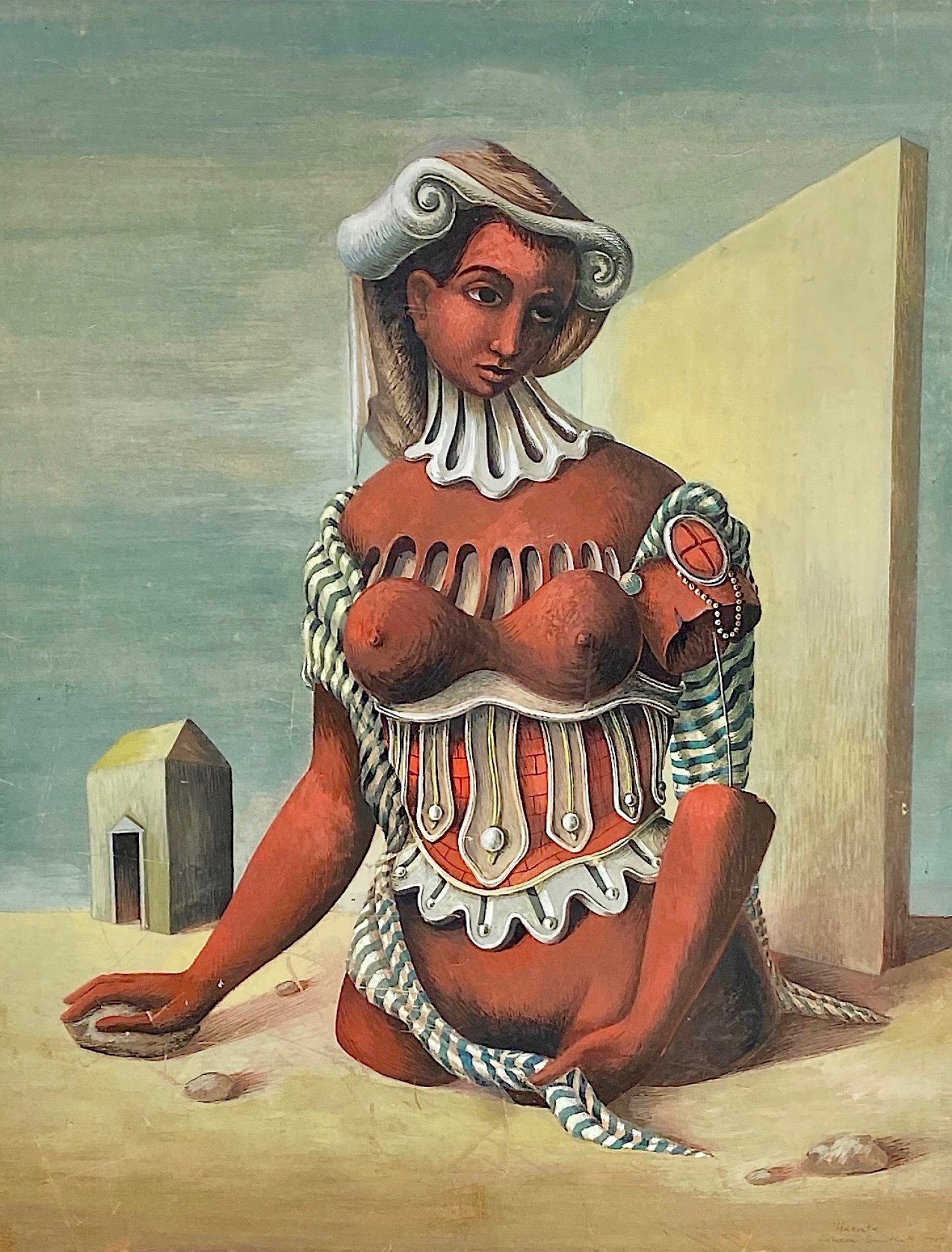Loudon Sainthill
Hecate, 1948
Gouache and mixed media on card
Inscribed 'Hecate', signed, dated 1948 lower right
56.5
x 45.8
cm
SOLD
Provenance:
Francis John Bagott Watson (Art historian with roles at the Courtauld, the Wallace Collection, the Royal Collection, the Slade, 1934 – 1992), thence by descent; Christies, London, 20 May, 2014, lot 187 (incorrectly dated as 1940). [Sir Francis Watson and his wife Jane lived in the house in London behind that of Sainthill and his partner Henry Tatlock Miller. See notes below].
Condition:
The work has had some minor scrapes and scratches that have been restored.
Exhibitions:
Similar Work: A watercolour Sore but Satisfied from the 1940s is illustrated at p155 of Fantasy Modern, Loudon Sainthill’s Theatre of Art and Life, Andrew Montana, University of New South Wales Press, 2014. This work 'theatricalises the dismembered mannequin form, popular with international Surrealists during the middle decades of the 20th century.'; Sore but Satisfied exhibited 'Merioola and After', S. H. Ervin Gallery, Sydney, 12 July - 17 August 1986, cat. 100, illus. p. 15; Loudon Sainthill Retrospective, Victorian Arts Centre, Melbourne, 12 September - 6 October 1991, cat. 40; Sore but Satisfied was offered at Sotheby's, Fine Australian Paintings, Melbourne, 27/11/1995, Lot No. 67.
Literature:
The standard texts on Sainthill are: Loudon Sainthill, edited by Henry Tatlock Miller, Hutchinson, 1973; Fantasy Modern: Loudon Sainthill's Theatre of Art and Life by Andrew Montana, UNSW Press, Australia, 2013. Sainthill collaborated with his partner Henry Tatlock Miller in producing three books: Royal Album (1951), Undoubted Queen (1958) and Churchill (1959).
Australian artist Loudon Sainthill achieved fame as a stage designer in London from the 1940s to the 1960s. He had previously lived at the house ‘Merioola’ in Edgecliff, Sydney, with a group of artists now known as ’the Merioola Group’. During the three Australian tours of Colonel W. de Basil's Original Ballet Russe, Sainthill had mingled with Russian dancers, painted their portraits and designed some sets for the ballets. He was approached to design Serge Lifar's Icare but Sidney Nolan was given the commission instead. As a ‘consolation prize’ Sainthill was invited to London with the Ballet Russe company.
Among Sainthill’s most renowned works were the sets and costumes he designed for Robert Helpmann's production of Rimsky-Korsakov's opera Le Coq d'Or at the Royal Opera House, Covent Garden (1954), completed at short notice when Marc Chagall withdrew from the commission. His designs were described as 'opulent', 'sumptuous' and 'exuberantly splendid'.
Sainthill’s paintings are sophisticated and often surreal and, in this regard, Hecate is probably at the extreme end of his scale. Hecate is a goddess in Greek mythology and is often associated with crossroads and entrance ways, not to mention sorcery. She is Queen of the witches in Macbeth. Beyond this, the meaning of the painting remains obscure. In writing about Sainthill’s very similar painting, Sore but Satisfied, 1947, Andrew Montana has written that it ‘theatricalises the dismembered mannequin form, popular with international Surrealists during the middle decades of the 20th century.’ (Sore but Satisfied, is illustrated at p155 of Fantasy Modern - Loudon Sainthill’s Theatre of Art and Life by Andrew Montana, University of New South Wales Press, 2014).
Hecate was one of a number of works by Sainthill owned by Sir Francis Watson and his ‘eccentric’ wife Jane who lived in a house at the rear of 8 Chester Street, London, the grand five-storied Regency brick-faced terrace where Sainthill and his partner Henry Tatlock Miller lived. An interesting story relating to the provenance of the painting is that Sainthill and Miller employed a Chinese ‘houseboy', Cheng Huan, and they helped him to learn English. Cheng got to know Sir Francis who eventually helped Cheng to study law. Cheng went on to study at Cambridge. In his obituary of Watson in 1992 his friend Sir Brinsley Ford wrote that Sir Francis ‘adopted Cheng, who later become one of the leading barristers of Hong Kong.’ (See Fantasy Modern, p466-475).




